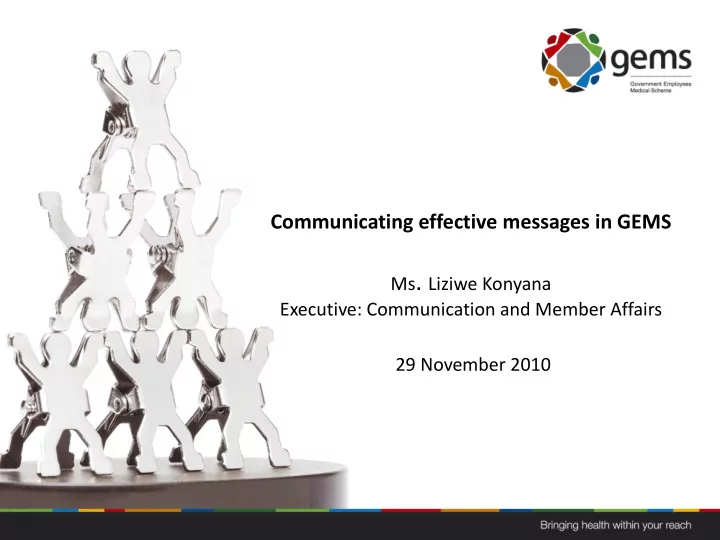

Communicating effective messages in GEMS Ms . Liziwe Konyana Executive: Communication and Member Affairs 29 November 2010
Purpose To illustrate how effective, clear and transparent communication plays a role in sustaining the Scheme’s success
Structure Strategic Objective and values Current Communication Environment Clear Communication Ethical and Transparent Communication GEMS Mandate vs. Competitive Environment Legislative Environment Closure
Strategic Objective & Values Vision To effectively market and position GEMS as an excellent Medical Scheme to all members and potential members, and significantly reduce the number of uncovered employees in the public service. Values Member orientation Clear Communication Simplicity Consistent Application Integrity Value for Money Prudence Excellence Flexibility Innovation Responsiveness
Current Communication Environment Usage of Mass Media – Traditional usage of media vs. member centricity • Dilution of information in the editorial process: will the target audience receive the intended message • Relevance - is it the best or most cost effective to reach our audience? • Responses to media coverage reinforced by communicating facts through targeted channels • Prudent buying of mass media space to ensure maximum awareness at the highest value *
Current Communication Environment Usage of other channels to communicate – Channels used are driven by member preferences • Scheme proactively identifies preferred channels of communicating • Scheme provides a variety of communication tools in which members can receive scheme information – Print (individualised mailing to 520 00 members) – Telephonic (11 000 calls per day) – Website (19 000 new visitors per month) – e-mail (29 % of members) – SMS (98% of members)) – Face-to-face interaction (2490 presentations to date in 2010; 1000 visits to our walk-in centres per day) – Member satisfaction survey indicates satisfaction with communication elements* • Effective communication (call centre) • Simplicity and ease of use (application forms) • Ease of understanding (statements) *Member Satisfaction Survey September 2010
Clear Communication Empowering Members – Plain language writing is used in all member communication – Focus of communication is on educating and empowering our members • 53% of members are accessing medical benefits for the first time • Encouraging members to understand the scheme, options, accessing benefits, treatment, cost and care administered • The message is about taking charge of own health and managing benefits adequately Communicating in 11 languages – Gradual implementation of a translation plan to ensure that members have access to information in a language they understand – Plan implemented from 2010 – Language profiling process is in place to identify preferred language
Ethical and Transparent Communication Integrity in marketing practices – Member recruitment drives are also health and wellness drives – Potential members understand what they are buying into – What they perceive to be buying is in fact what they are buying – No false marketing Integrity in member communication – Continuous, customised and proactive communication to members about their benefits and usage – Informing members about their rights as consumers of medical schemes and healthcare services – Proactively informing members of entitlements beyond their perceived benefits (e.g. PMBs) and possible interventions (e.g. Ex Gratia process) in the interest of health – Packaging of information to promote confidentiality and privacy (e.g. Information on Aid for AIDS)
Ethical and Transparent Communication Transparency in communicating governance and financial performance – Premise: The Scheme is accountable first to members – Encouraging member participation in Scheme processes • AGM attendance and Annul Report review • Nomination and election of Board members Communicating what others will not communicate – No misleading figures and statistics (average contribution increases) – Honest communication about trends driving the Scheme’s financial and operational performance – Members take informed decisions about associated risks and effects on their own finances and healthcare (the schemes growth, clinical risk profile) – This approach may present scheme in negative light compared to other schemes in the short term – In the long term honesty, transparency and consistency will ensure member expectations are met and therefore build trust, goodwill and sustained member retention and growth
GEMS Mandate vs. Competitive Environment GEMS operates and communicates differently to other schemes due to its mandate Mandate from Government – To increase access to healthcare benefits for all public servants – The focus is not on profit making but on universal coverage – Benefit design is centred around affordability and equitable access Promoting government priorities – Extending health and wellness services to all public servants – Providing health and wellness information to all public servants – Interface with all public servants identified as requiring managed care regardless of medical scheme membership An improved value proposition* – 2 nd most affordable but with more benefit offerings than the most affordable scheme – More comprehensive benefits in line with what is accessed in public health system – Services geared towards member satisfaction and improved managed care interventions *Affordability Report 2010
The Legislative Environment Addressing consumer rights legislation – Consumerism Plan • Promoting members’ rights as consumers of medical schemes • Empowering members to be proactive consumers of healthcare services • Ensuring members understand the processes, networks, services and benefits and how to access these Promoting access to Information – Translation Plan • Equitable access to Scheme communication material • Accessing Scheme services in the language of choice • Access to information on Scheme rules, Medical Schemes Act, CMS information and GEMS annual reports Protecting the rights to privacy – Human Resources practices geared towards ensuring confidential treatment of information as employees interface with members in the communication environment – The packaging and distribution of information promotes confidentiality and privacy
Closure Clarity, transparency and consistency are key to effective communication Effective Communication is central to building an ethically sound organisation Honest and transparent communication may lead to negative perceptions in the short term The investment in mechanisms, systems, operations and communication tools that promote effective communication will yield long term and sustainable results for organisations Ethics and Values do make business sense
Recommend
More recommend